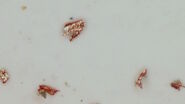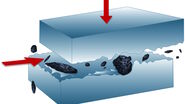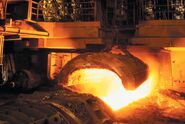Introduction
A large number of products and applications require materials analysis. Examples are found in the metal alloy, automotive, aerospace, and electronics industries, as well as the fields of metallurgy/metallography, earth science, and materials science [1]. Finding a balance between the need to ensure product quality or reliability of research results and the cost of analysis becomes a serious concern.
Much time and money is spent using multiple techniques, such as optical and scanning electron microscopy (SEM) along with energy dispersive spectroscopy (EDS). They are used to visually inspect (microscopic image generation with high resolution and sharp contrast) a material and identify its local composition (qualitative chemical/elemental spectroscopic analysis). Methods like SEM/EDS require special sample preparation and transfer of the sample into vacuum, which is time consuming, for observation and analysis. In most cases, reliable data for a material’s local morphology and composition are vital for determining a further course of action for the specific application, especially if confident decisions must be made despite serious time and budget constraints.
A solution which offers precise, reliable visual and chemical analysis in one instrument, requires little or no sample preparation, and operates with the sample in ambient conditions would greatly increase workflow efficiency. Such a device would allow both time and cost savings when doing materials analysis.
An example of such a solution is described in this report, the DM6 M LIBS materials analysis system from Leica Microsystems (refer to figure 1). It combines optical microscopy (visual analysis) with laser induced breakdown spectroscopy or LIBS (chemical analysis). The basic operating principles and workflow advantages of a 2-in-1 solution are discussed.
Basic Principles of LIBS
What is Laser Induced Breakdown Spectroscopy (LIBS) and how does it make qualitative elemental/chemical analysis possible?
The mechanism of LIBS, which enables material composition analysis, occurs in several basic steps (refer to figure 2 below) [2]:
- A high energy laser pulse strikes a targeted area of the analyzed material surface (figure 2A);
- The laser energy is absorbed causing local area ablation and crater formation (figure 2B);
- A plasma is induced (free atoms and electrons) with simultaneous light (continuous spectrum) emission;
- Plasma breakdown (relaxation) follows immediately with emission of elemental line spectra;
- The line spectra are detected and the corresponding elements identified (figure 2C).
Efficient Workflow for Materials Analysis
A 2-in-1 solution combining optical microscopy (OM) with LIBS reduces significantly the amount of effort required to do the analysis workflow. Why is analysis with a 2-in-1 OM + LIBS solution more efficient than optical and scanning electron microscopy plus energy dispersive spectroscopy (OM + SEM/EDS)? Simply because the most time-consuming work steps are eliminated. The 2-in-1 OM + LIBS solution requires, both before and after the initial material inspection:
- No sample preparation before doing analysis;
- No sample transfer from an optical to electron microscope;
- No relocating the region of interest (after sample transfer); and
- No system adjustment (after sample transfer).
All these steps are typically done for analysis with OM + SEM/EDS [3-5]. Figure 3 below shows graphically the differences between the workflows.
The additional work steps listed above required for chemical analysis when using a device, such as a SEM, are often skipped during the materials inspection, due to their complexity and typical restraints on money and time. Still, there is a risk when the local material composition data is not available: without all the relevant information, it may not be clear what the right decision would be for the next work step or action. Then there is a higher risk of not achieving the targeted product quality.
Comparison between the Most Common Materials Analysis Techniques
At present, the most commonly used methods for materials analysis are:
- Optical microscopy (OM);
- Scanning electron microscopy (SEM) with energy dispersive spectroscopy (EDS);
- Optical emission spectroscopy (OES);
- Inductively coupled plasma mass spectrometry (ICP-MS); and
- X-ray fluorescence spectroscopy (XRF).
These methods listed above, as well as a 2-in-1 solution combining OM with LIBS, have specific operational requirements, analytical functions, and can deliver certain results. Table 1 below shows a comparison between the methods. There are distinct advantages seen for a 2-in-1 solution (OM + LIBS).
| Materials Analysis Method | ||||
Requirement / Function / Result | OM + LIBS | SEM + EDS | OES | ICP-MS | XRF |
Sample Preparation | No | Yes | No | Yes | Yes |
Sample Analyzed in Air | Yes | No | Yes | No | Yes |
Time To Results | Seconds | Minutes | Seconds | Minutes | Minutes |
Microscale Elemental Analysis | Yes | Yes | No | Possible with laser ablation | Possible with micro-XRF |
Atomic Spectra | Yes | Yes | Yes | Yes | Yes |
Depth/Profile Analysis | Yes | No | Possible, very rare | No | No |
Microstructural Analysis | Yes | Yes | No | No | Possible with micro-XRF |
Image Data | Color, optical contrast methods | No color, electron contrast methods | None | None | None |
Sample Size | Up to 150 x 150 x 30 mm (L x W x H) | Depends on sample chamber | Up to >20 cm each dimension | - | - |
Sample Properties | Any solid, metallic or insulating | Solid, non-volatile in vacuum, metallic or insulator coated with conductive layer | Solid, metallic or conductive | Any solid, suspended in aerosol | Any solid, pulverized |
Table 1: Comparison between several materials analysis methods in terms of their operational requirements, analytical functions, and the results delivered.
Summary
In this report, the basic operating principles and advantages of a 2-in-1 materials analysis solution for an efficient analysis workflow were presented. A 2-in-1 solution achieves these benefits by the combination of optical microscopy and laser induced breakdown spectroscopy (LIBS) for simultaneous visual and chemical inspection of materials.
Materials analysis is important for many types of product development, quality control, failure analysis, and technical applications and is used routinely in multiple industries and fields, like transportation, electronics, metallography/metallurgy, and materials science. Often the time and expense allocated for such analysis is limited, but obtaining reliable results and achieving the desired product quality always remains a priority.
An example of a 2-in-1 solution is the DM6 M LIBS materials analysis solution from Leica Microsystems. It offers accurate, rapid visual and chemical analysis in one instrument, eliminates sample preparation and transfer, and does not require the sample to be in vacuum. Either dry or wet samples in air can be analyzed. These advantages enable users to perform fast, precise, and economical materials analysis.








